With home learning now established as the new ‘normal’ for teaching our students, I am really beginning to miss my classroom. So much so, that I thought I would take you on a little guided tour…
I know, in many schools for different reasons, it is not always possible for staff to have their own classroom. In the early stages of my career, this was the case for me as well. When I joined my current school I was lucky enough to inherit a classroom to call my own.
A classroom, for me, is a safe space for students to explore new subject knowledge, get inspired and share their learning experiences. So upon entering my classroom I want both students and staff to feel comfortable and not overwhelmed.
In my mind, my classroom will always be a working progress. You may find it frustrating to think that your classroom will never be finished, but I truly love the creative process involved in designing, organising and presenting a space so much so that I am happy to invest my time and energy (when I have it).
PART 1; A tour of my displays
I have to admit, I am a sucker for a display. Over the years I have done more than I can count (see previous blog post). But when it came to my classroom I wanted the displays to be attractive, yet functional, displaying content which would be purposeful and could be continuously referred to. Whilst, the corridor could display additional content such as field trips and career opportunities. Content which may be considered distracting. You yourselves may not agree, but that is your opinion, I accept that everyone is different.
With vocabulary being a critical aspect and/or barrier to some student’s learning I chose to design two displays which focus on key vocabulary and geographical fluency.

The first (above) displays a wide range of key geographical terminology with images, designed for low ability, SEN, EAL students in mind. As well as the correct spelling of envi’ron’ment, a commonly misspelt key word. Whereas the second display, speak like a geographer (below), is used to showcase good geographical oracy for all abilities.
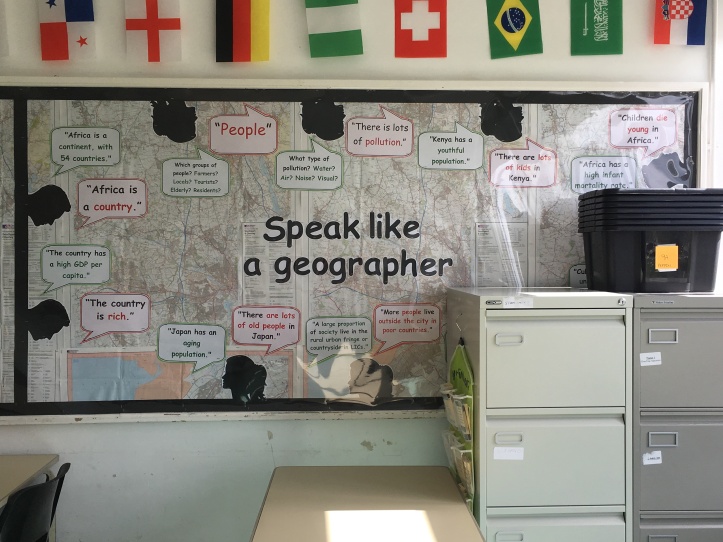
The left side of my classroom (below) displays the Geographical Association’s age related progression framework, which has been embedded into each of our departmental schemes of work for Key Stage Three. During lessons I will direct student attention to this, to demonstrate their progression from Year 7 through to Year 11 sharing our five year learning journey.
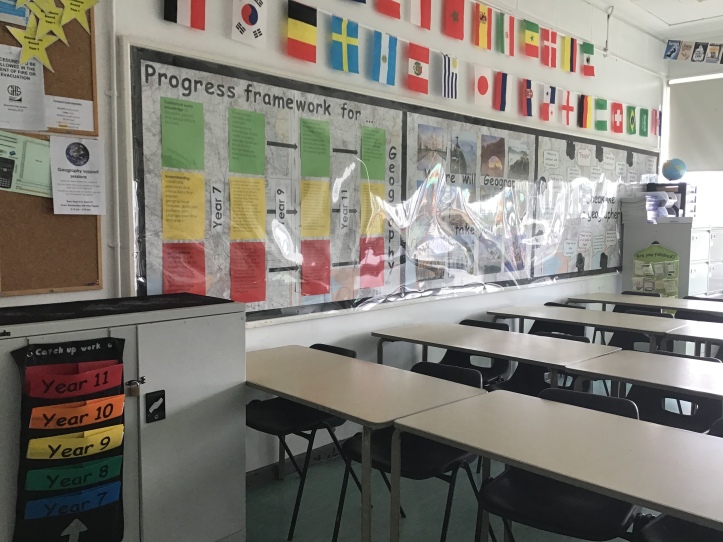
In addition, the centre section of the display contains images of ‘fantastic’ places. No geography classroom should be without a display that establishes a sense of place, awe and wonder.
The back of my classroom is kept to a minimum, used mainly for storage and organising resources. I did not want it to attract too much student attention, as they should be listening to instructions or completing activities.
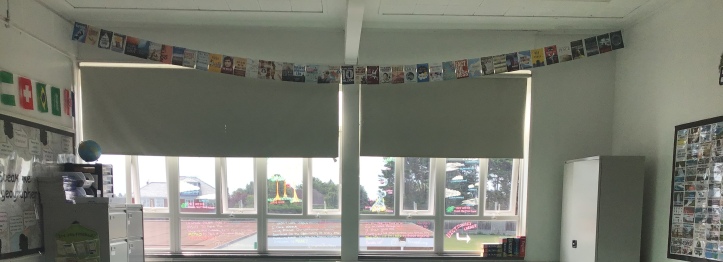
But at the same time, I did not want it to look too ‘plain’. A geography related book bunting (see above) lines the entire ceiling, promoting literacy. Whilst, more recently, I took the time to draw on a selection of windows (see below). The windows, at times, can become a distraction so the blinds are used at my discretion.
The front of my classroom has been kept as minimal as possible, as well, to avoid sensory overload. A GCSE command word bunting (see below) and definitions line the right side of my classroom ceiling, for reference with my GCSE classes. Whilst, classroom expectations are displayed underneath for me to refer to when needed (see previous blog post).
Surrounding my interactive whiteboard you will find approved vs banned words when providing descriptive locations. These, in particular, have shown real impact over the last few years. With students becoming more accustomed to using the correct geographical language when providing location descriptions.
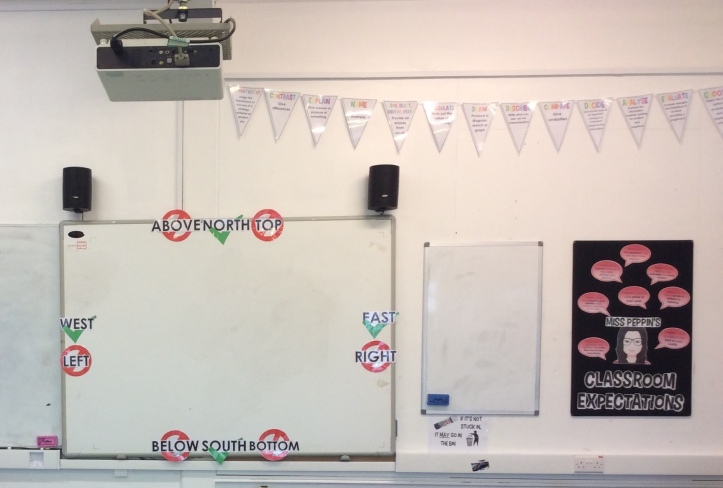
PART 2; The age old decision of rows, horse shoe or groups.
My classroom is slightly longer compared to its width. After briefly trialing a horse shoe, I found moving around the classroom in order to monitor students progress restricting due to the narrow width. So it is here I must stress, work with your space and go with what is most comfortable for you.
Rows, was the layout I decided upon, to encourage concentration and increase engagement from forward facing students. Rows, in my opinion, also benefit behaviour management. So even though I cannot ‘work the walls’ in my room and rotate around the edges of my classroom, I make a point to move forwards and backwards during lessons. Also the extra length in my room provides plenty of space for me to get between rows if a student requires assistance.

PART 3; Storage and stationary
We teachers accumulate a lot of ‘stuff’ throughout the course of a year, and even more during the length of our careers. Although I try my best to not hoard resources, worksheets, DVDs, textbooks and stationary which may serve a future purpose. Utilising storage space is a must, regardless.
Personally, I have two filing cabinets at the back of my classroom dedicated to spare worksheets and resources such as files, books and past examination papers. As well as a metal cabinet I use to store students’ exercise books.
An additional cabinet, at the front of my classroom, stores my ‘poundland pedagogy’ and miscellaneous resources such as balloons, post cards, rock collection, tumble towers, beer pong cups, ping pong balls etc. You name it, I probably have it!
Whiteboards, atlases and paper based items can be found at the back of my room. As well as a dictionary corner, containing multiple copies, available to any student wishing to check/double check spellings. By placing these resources at the back students, during the course of the lesson, can walk to the back without disturbing any teacher instructions and students in front.
Any other stationary items such as colour pencils, glue, scissors, rulers can be found in the front cabinet previously mentioned.
I consciously made the decision to separate stationary across my classroom, so students could move around the room more, but also to avoid a mass pile up of students waiting for resources. If an activity requires paper and scissors, students will sensibly divide themselves (relatively equally) between the two areas. Otherwise there tends to be a lot of standing around and waiting, which delays learning.
PART 4; Catch up folders
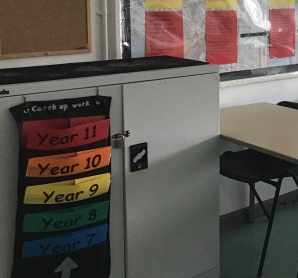 Year group catch up folders are located on the additional cabinet, previously mentioned, at the front of my classroom. This is where I store student absent work. Upon returning to school, students can check the catch up folder for any missed work and take it home.
Year group catch up folders are located on the additional cabinet, previously mentioned, at the front of my classroom. This is where I store student absent work. Upon returning to school, students can check the catch up folder for any missed work and take it home.
It is purposefully placed at the front for ease of access upon entering and exiting my classroom, serving as a reminder for both myself and students to check if recently absent.
PART 5; Bins (how exciting… NOT!)
As a geographer, I feel obligated to demonstrate ‘good’ habits surrounding the sheer amount of waste classrooms accumulate throughout the day.
My current school has a great system already in place when it comes to recycling paper and cardboard, with weekly collections. However, the broadcasting of BBC Blue Planet II where David Attenborough brought to light the impacts of plastic on our environment sparked my desire to commit to the process of recycling further.
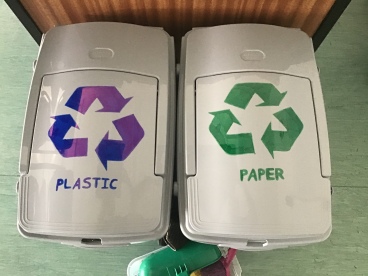
I chose to invest in an additional bin, for the sole purpose of plastic recycling. My school, at present, does not have the facilities or additional funding to provide such at a whole school level. So, I monitor this myself and when appropriate take the contents to the recycling centre.
These recycling bins are also, consciously, placed in a more accessible location in my classroom than the general waste bin. Students walk past these first, raising and promoting the importance of recycling, before considering if the rubbish is for the general waste.
And finally, the MAP!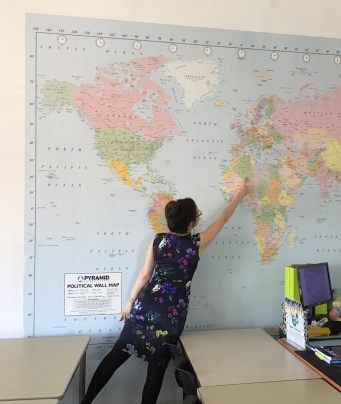
A geography classroom is not complete without a world map(s), but this I inherited when joining the school (admit it, your jealous!). Located next to my desk, it extends from floor to ceiling, allowing me to continuously reference and draw attention to locations and regions applicable to the lesson.
How the functionality of my classroom will work post-COVID is something I may need to consider upon our return, but for now … I hope to return to it soon!



